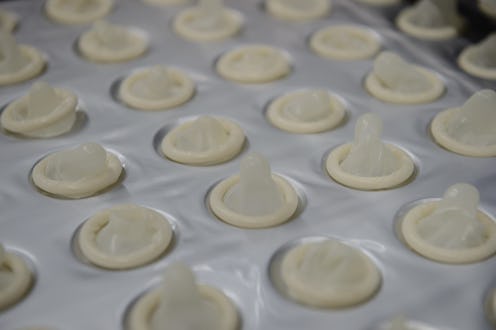Life
Free Condoms For Buffalo, NY High School Students
The strides in youth sexual health are continuing in upstate New York; this week, the Buffalo School Board "approved a plan... that will allow school nurses to provide condoms to students." The Condom Availability Program (CAP) is part of the district's already-existing sex education program. Ideally, free condoms would be available to any high school student at any time in their education. While ninth grade students through twelfth grade students have access to CAP, the policy states that “condoms shall be made available only to students who have successfully completed the required HIV/AIDS/sexual health instruction program in their Health Education class." Still, the announcement of the program is exciting, especially since district leaders have said that CAP "will be implemented as part of a wider education plan" in continuing efforts to improve student safety and health.
Earlier this month, the New York City Department of Education announced a surprisingly delayed sex education policy change, finally allowing condom usage demonstrations to be included in high school health class curriculum.
Not surprisingly, pearl-clutching parents have expressed outrage. Rightly citing STDs and teen pregnancy as a public health issue, the district had wanted to implement a condom program for a few years, but pushback from families impeded the process. This recent approval only came after months and months of public meetings, featuring plenty of parental anger. At one of the meetings, a parent commented, “Giving my child a condom in school is telling my child it's OK to go do what you want to do without your parent." Actually, providing your children with condoms could very well save their lives and stop unwanted pregnancy, because if they want to have sex, they are going to have sex — whether or not they have your permission. When will people understand this fact? Previous research also shows that student access to condoms doesn't make people sexually active; it makes sexually active people safer. Studies of condom availability programs in New York City find that there is “a significant increase in condom use among sexually active students, but no increase in sexual activity.” Additionally, we have already seen the catastrophes that occur when schools ignore sex education and sexual health resources in hopes that students won't realize that sex is a thing. Remember the chlamydia outbreak among students at an abstinence education-only Texas high school only 2 months ago?
Thankfully, the Buffalo Public School District overruled the puritanical outcry and pointed any critic's attention toward the distressing facts. Assuntra Ventresca, who is the Director of Health Related Services for the district, told WIVB News 4, “We have the highest pregnancy rate in the state among our teens. We identify over 200 students annually that are pregnant.” Additionally, the most recent research revealed that 44 percent of high school students in Buffalo reported having sex. Out of these sexually active teens, 35 percent reported not using protection during their last sexual encounter.As is the case with sex education programs, parents will have the ability to opt their children out of CAP. We can only hope that most of the district parents understand human sexuality, and recognize the prevention of unwanted pregnancy, STI/STDs transmission, and HIV/AIDS transmission as the public health issue that it is.The CDC has released studies proving that STD and HIV prevention programs in schools “play [a] key role” in stopping the spread of HIV and STDs and lowering risky sexual behaviors. Students deserve absolute access to sexual knowledge, safety, and health.
Buffalo isn't the only place where school programs have expanded to further combat sexual health issues. Here are three more of them:
1. Seattle
A Washington State Medicaid Program, Take Charge, has established school-based sexual and reproductive health clinics at several public high school and middle schools in Seattle. The clinics provide free contraception (including condoms, the Pill, IUDs, and the Nexplanon implant) and free counseling. Hundreds and hundreds of teenagers have been able to receive birth control, doctor's appointments, and private counseling without the fear of parental shame; not only are the clinic services free, but they don't require any proof of their families' insurance. This is key, since a 2015 survey by The National Campaign to Prevent Teen and Unplanned Pregnancy revealed that 68 percent of teens cite “not wanting their parents to find out” as the reason they forgo birth control.
2. Philadelphia
/All public high schools in the city of Philadelphia have access to The Philadelphia High-School STD Screening Program, which provides access to yearly free and confidential STD tests for any student who desires one. The program also includes educational workshops about chlamydia and gonnorrhea, reaching about 30,000 high schoolers every year. Of the 30,000 students, about half opt to take the STD tests. The Philadelphia Department, School District of Philadelphia, and the Family Planning Council collaborated after STD rates among Philadelphia youth, specifically for chlamydia and gonorrhea, “reached epidemic proportions” in 2000.
3. San Bernardino
The California Family Health Council (CFHC) has included its own Condom Availability Program (CAP) since 2012. Their CAP provides free, confidential “individual home mailers” to nine areas in California with the highest teen STD rates. The program, on TeenSource.org, allows teens “to go online and confidentially request a package of 10 condoms, personal lubricant (to reduce breakage), and educational information” every month. So far, CAP has sent out almost 90,000 condoms since the program started three years ago. In February of this year, the county of San Bernardino became the newest member of CAP, joining San Diego, Los Angeles, Alameda, San Joaquin, Fresno, San Francisco, Kern, and Alameda. While California teens already have “the highest rates of gonorrhea and chlamydia” among all ages in the state, San Bernardino County specifically comes in at number 5 for the most chlamydia rates and number 11 for the most gonorrhea rates, out of 58 counties in California.
Images: Giphy (3)
